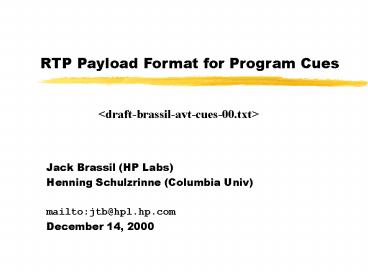RTP Payload Format for Program Cues - PowerPoint PPT Presentation
Title:
RTP Payload Format for Program Cues
Description:
RTP Payload Format for Program Cues. Jack Brassil (HP Labs) Henning ... SSRC & PT fields instead of proposed payload so players like WinAmp not confused : ... – PowerPoint PPT presentation
Number of Views:100
Avg rating:3.0/5.0
Title: RTP Payload Format for Program Cues
1
RTP Payload Format for Program Cues
ltdraft-brassil-avt-cues-00.txtgt
- Jack Brassil (HP Labs)
- Henning Schulzrinne (Columbia Univ)
- mailtojtb_at_hpl.hp.com
- December 14, 2000
2
Program Cues
- A Program Cue is
- a signaling message used to convey program
identity, structure and timing - intended for communicating events whose precise
timing is significant to receivers (e.g.,
program start/stop times) - the building block for a cueing protocol
3
Cueing Protocols - Purpose
- Anticipate that both network intermediaries and
clients will receive and process growing number
of concurrent RTP streams - Cues facilitate application creation
- Program recording
- Ad insertion/media personalization
- Program modification (e.g., logo overlay)
- Switching
- Adaptation (e.g., image extraction)
- Notifications (e.g., parental advisorys,
emergencies) - Stream monitoring (e.g., DRM)
4
Program Notifications in Traditional Broadcast
Media
- Radio Data System (RDS) in VHF/FM
- traffic alerts, program info out-of-band on
alternate frequencies - requires RDS-capable radio, often with
alphanumeric display - smart receiver can do automatic channel
switch-over - Program Delivery Control (PDC)
- Program Identity Labels, start stop times
- carried in teletext
- requires PDC-capable VCR (Gemstars ShowView,
VideoPlus) - Local Program Insertion and Pass Thru
- DTMF control channel
- obvious A/V artifacts from poor timing control
5
Cueing Protocols Basic Properties
- Cues are always optional in RTP stream
- Each cue is a separate packet (distinguished by
Payload Type) - Cues can be added or removed by an intermediary
- Media encoding independence (e.g., PCM, MPEG-4)
- In-band or out-of-band operation
- Compatible with push or pull systems
- Encourage conventions but let application
developers decide how to construct protocols
6
Basic Cue Types
- Event Notification (EN) - indicates start of
event - Event Continuing (EC) - event in progress
- Event Termination (ET) - indicates end of event
- Event Pending (EP) - indicates upcoming event
7
Proposed Payload Format
8
Operational Details
- Redundant notifications are OK
- EN and ET cues should be placed in stream at
event points - Applications insert EP and EC as necessary
- Reliability enhancements to RTP apply
9
Cueing Protocols Related Activities
- Other less time-sensitive RTP payloads for
metadata being examined - Analogous to origin-edge server communication in
I-CAP - Some apps possible with other methods of
synchronization (e.g., SMIL or wall clock time) - RTP named events
10
Cueing Protocols - What works today
- Local transmission of audio as MP3/RTP/IP
multicast - Embedded structural cues
- Applications
- track recording service
- third party ad insertion
- Hack encodes SSRC PT fields instead of
proposed payload so players like WinAmp not
confused )
ltprogram idgt lttrack 1gt lt/track 1gt
ltad slot 1gt lt/ad slot 1gt
lt/program idgt
11
Program Cues - Issues
- Authenticating cues
- Invocation via RTSP
- Identification of Event Types
- Description and announcement via SDP/SAP
- Need for cues to convey program semantics?
- Filters and compatibility with existing apps
12
Program Cues - Recommendation
- Sufficient interest to consider standards track
- Need to avoid early adoption of proprietary
mechanisms - Interested parties include
- traditional broadcasters
- edge technology providers
- media application developers
- CDNs































